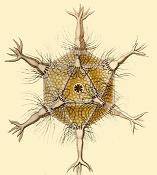Radiolaria: Difference between revisions
No edit summary |
GrahamBould (talk | contribs) Undid revision 268412011 by 76.212.191.67 (talk) |
||
| Line 15: | Line 15: | ||
}} |
}} |
||
'''Radiolarians''' (also '''radiolaria''') |
'''Radiolarians''' (also '''radiolaria''') are [[amoeboid]] [[protozoa]] that produce intricate [[mineral]] [[skeleton]]s, typically with a central capsule dividing the [[cell (biology)|cell]] into inner and outer portions, called [[endoplasm]] and [[ectoplasm]]. They are found as [[zooplankton]] throughout the ocean, and their skeletal remains cover large portions of the ocean bottom as [[radiolarian ooze]]. Due to their rapid turn-over of species, they represent an important [[Fossil|diagnostic fossil]] found from the [[Cambrian]] onwards. Some common radiolarian fossils include ''[[Actinomma]]'', ''[[Heliosphaera]]'' and ''[[Hexadoridium]]''. |
||
==Description== |
==Description== |
||
Revision as of 06:34, 4 February 2009
| Radiolaria Temporal range: Cambrian - Recent
| |
|---|---|

| |
| Radiolaria illustration from the Challenger Expedition 1873-76. | |
| Scientific classification | |
| Domain: | |
| Kingdom: | |
| Superphylum: | |
| Phylum: | Radiolaria Müller 1858 emend.
|
| Classes | |
Radiolarians (also radiolaria) are amoeboid protozoa that produce intricate mineral skeletons, typically with a central capsule dividing the cell into inner and outer portions, called endoplasm and ectoplasm. They are found as zooplankton throughout the ocean, and their skeletal remains cover large portions of the ocean bottom as radiolarian ooze. Due to their rapid turn-over of species, they represent an important diagnostic fossil found from the Cambrian onwards. Some common radiolarian fossils include Actinomma, Heliosphaera and Hexadoridium.
Description

Radiolarians have many needle-like pseudopodia supported by bundles of microtubules, called axopods, which aid in the Radiolarian's buoyancy. The nuclei and most other organelles are in the endoplasm, while the ectoplasm is filled with frothy vacuoles and lipid droplets, keeping them buoyant. Often it also contains symbiotic algae, especially zooxanthellae, which provide most of the cell's energy. Some of this organization is found among the heliozoa, but those lack central capsules and only produce simple scales and spines.
The main class of radiolarians are the Polycystinea, which produce siliceous skeletons. These include the majority of fossils. They also include the Acantharea, which produce skeletons of strontium sulfate. Despite some initial suggestions to the contrary, genetic studies place these two groups close together. They also include the peculiar genus Sticholonche, which lacks an internal skeleton and so is usually considered a heliozoan.
Traditionally the radiolarians have also included the Phaeodarea, which produce siliceous skeletons but differ from the polycystines in several other respects. However, on molecular trees they branch with the Cercozoa, a group including various flagellate and amoeboid protists.
The other radiolarians appear near, but outside, the Cercozoa, so the similarity is due to convergent evolution. The radiolarians and Cercozoa are included within a supergroup called the Rhizaria.
Some radiolarians are known for their resemblance to regular polyhedra, such as with the icosohedron-shaped Circogonia icosahedra pictured to the left.
Fossil record
The earliest known radiolaria date to the very start of the Cambrian period, appearing in the same beds as the first small shelly fauna - they may even be terminal precambrian in age. They differ little from later radiolaria.[1]
Haeckel's radiolarians
German biologist Ernst Haeckel produced exquisite (and perhaps somewhat exaggerated) [citation needed] drawings of radiolaria, helping to popularize these protists among Victorian parlor microscopists alongside foraminifera and diatoms.
Illustrations from Haeckel's Kunstformen der Natur (1904)
-
1. Phaeodaria
-
11. Discoidea
-
21. Acanthometra
-
22. Spyroidea
-
31. Cyrtoidea
-
41. Acanthophracta
-
51. Polycyttaria
-
61. Phaeodaria
-
71. Stephoidea
-
91. Spumellaria
References
- ^ Vickers-Rich, Patricia; Komarower, Patricia, eds. (2007), The Rise and Fall of the Ediacaran Biota, Special publications, vol. 286, London: Geological Society, ISBN 978-1-86239-233-5, OCLC 156823511
- Zettler, Linda A. (1997). "Phylogenetic relationships between the Acantharea and the Polycystinea: A molecular perspective on Haeckel's Radiolaria". Proceedings of the National Academy of Sciences. 94: 11411–11416. doi:10.1073/pnas.94.21.11411. PMID 9326623.
- P. Lopez-Garcia; et al. (2002). "Toward the Monophyly of Haeckel's Radiolaria: 18S rRNA Environmental Data Support the Sisterhood of Polycystinea and Acantharea". Molecular Biology and Evolution. 19 (1): 118–121.
{{cite journal}}: Explicit use of et al. in:|author=(help) - Sina M. Adl; et al. (2005). "The New Higher Level Classification of Eukaryotes with Emphasis on the Taxonomy of Protists". Journal of Eukaryotic Microbiology. 52 (5): 399–451. doi:10.1111/j.1550-7408.2005.00053.x.
{{cite journal}}: Explicit use of et al. in:|author=(help) - Haeckel, Ernst (2005). Art Forms from the Ocean: The Radiolarian Atlas of 1862. Munich; London: Prestel Verlag. ISBN 3-7913-3327-5.










